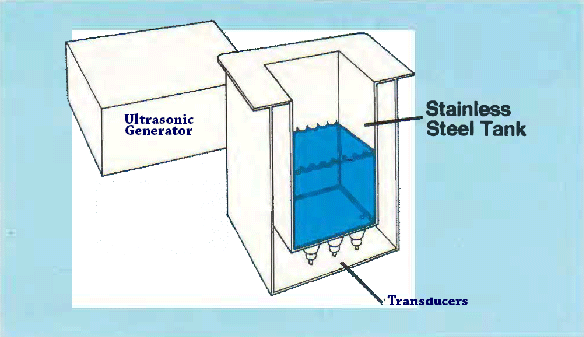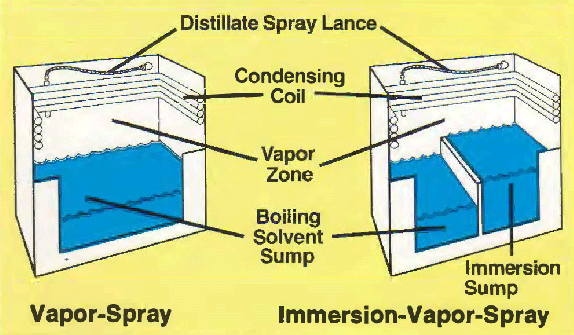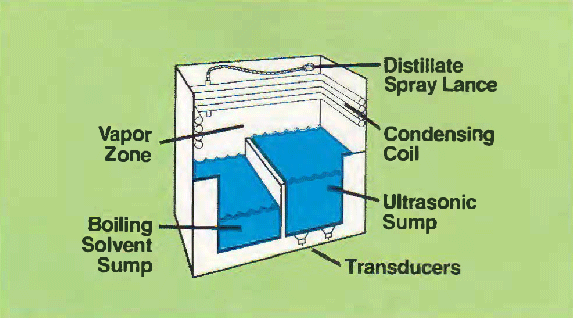 We are distributors for most of the major USA manufacturers of ultrasonic cleaning equipment. If you are in the market for new equipment, we can help you select the best equipment for your application. We can also design custom equipment to meet your special needs.
We are distributors for most of the major USA manufacturers of ultrasonic cleaning equipment. If you are in the market for new equipment, we can help you select the best equipment for your application. We can also design custom equipment to meet your special needs.
- Unusual tank shapes
- Multi station lines
- Automated lines
- Most efficient distribution of ultrasonic energy
- Special applications
- Install new ultrasonic transducers on old systems
- Update equipment
The methods for cleaning using ultrasonics varies by a number of factors including:
- Size of the item to be cleaned
- Type of material that will be cleaned
- Quantity of items that require cleaning
- Type of contaminants that must be removed (detemines which solvents are needed)
- Cleaning Temperature
Our expert engineers will take this information and design the most cost effective method of achieving your cleaning goals.
Cleaning Problems
Whenever products get dirty, with anything from fingerprints to plating salts, those contaminants can be tough to remove. For example, difficult soils accumulate on manufactured products during processing; on electrical components, engine parts and jewelry simply with time and exposure. Such soils are often insoluble in common cleaning solutions.
Also, cleaning efforts may be complicated by product material or part configuration. There may be strict cleanliness standards to meet, or requirements for high volume batch cleaning. Where cleaning must be accomplished in step with a production line, speed is important. Manufacturers are particularly concerned with the effects of improper or insufficient cleaning: increased rejects and rework of products, customer complaints, callbacks and warranty repairs.
For every one of these problems, high efficiency cleaning techniques have been developed. Properly selected processes and products can bring cost effectiveness to cleaning procedures in any setting from the hobbyist's bench to the industrial complex.
Basic Considerations
Properly applied and intelligently used, ultrasonic can do a more thorough, more complete cleaning job than any other cleaning method presently known.
Investment in ultrasonic equipment, however, must always be justified by savings whether the savings be realized in reduced labor costs, in fewer rejects, or in improved quality that will lead to better customer acceptance of a product.
As with any new tool, it can be used better and applied to the right job correctly when the user understands what it is and how it works.
To start with, it is well to realize three basic facts about ultrasonic cleaning...
- Parts to be cleaned must be immersed in a liquid.
- Generally, with some important exceptions, the entire volume of liquid must be supplied with ultrasonic energy.
- The use of ultrasonics does not eliminate the use of cleaning chemicals.
Cleaning Action with Sound Waves
In ultrasonic cleaning, the pressure phase of a sound wave is used in a very interesting way. A transducer, attached to the bottom of a cleaning tank, is designed so that its face (the tank bottom) is a point of minimum pressure. When the tank is filled with liquid to a depth which is a multiple of a half wave length, a strong standing wave is established.
In that zone in the liquid where a negative pressure exists, the boiling point drops because of the lowered pressure. Or, one might say the pressure is reduced to less than the vapor pressure of the liquid, and thousands of minute vapor bubbles are formed. A half cycle later, in 1 /40,000 of a second at 20 KHz, the pressure in this same zone becomes positive, and the vapor bubbles implode burst inwardly with great violence. This is "cavitation" and is not to be confused with the formation of air bubbles caused by degassing of the water.
While the quantity of energy in any one implosion is extremely small, it is calculated that enormous pressures (in the order of 10,000 pounds per square inch) and extreme temperatures (approximately 20,000° F) are developed.
It is the formation and bursting of these vapor pockets with their fantastic pressures and temperatures that does the scrubbing. The sound waves are simply the mechanical means to achieve cavitation.

Ultrasonic Aqueous Cleaning
Ultrasonic cleaning is based on the principle of cavitation the rapid formation and collapse of minute bubbles in a cleaning liquid, caused by the introduction of high frequency sound waves. Agitation by millions of these bubbles creates a highly effective scrubbing action on all surfaces of parts immersed in the liquid. A key benefit of ultrasonic cleaning is its ability to penetrate tiny crevices, complex assemblies and recesses that are largely "untouchable" by any other method.
The three essential components of an ultrasonic cleaning system are:
- A tank to hold the cleaning liquid.
- An ultrasonic generator to convert line current into high frequency, high voltage electrical energy.
- A transducer to convert high frequency electrical energy into mechanical energy.
Options may be added to these essentials; such as tank heaters to maintain the most efficient cleaning temperature.
We build ultrasonic cleaning equipment for a wide selection of aqueous {water based) solutions; a separate series can handle strong acids and caustics. Our Ultrasonic cleaners are available as integrated units in a single, compact enclosure, or as individual components for custom installation.
 Vapor Degreasing
Vapor Degreasing
Basically, vapor degreasing involves suspending work pieces in warm, pure vapors generated by boiling a cleaning solvent. Rather than water based cleaning agents, vapor degreasing uses fluorinated or chlorinated safety solvents. Specially developed for vapor degreasing, these solvents are nonflammable and nonexplosive.
As solvent vapors condense on the relatively cool work piece, liquid condensate washes away contaminants. This cleaning action continues until the work reaches vapor temperature. Condensation then ceases and the work is removed from the vapor zone clean and dry. This vapor cleaning process is often combined with immersion in warm or boiling solvent and spraying with distilled solvent to meet specific cleaning needs.
Integrated vapor degreasers are especially useful for multistage cleaning of metal parts and assemblies prior to inspection or final assembly. Other materials such as glass and plastics are also safely and effectively cleaned by vapor degreasing. units may be used for vapor only, vapor spray, or immersion vapor spray cleaning sequences.
 Ultrasonic Vapor Degreasing
Ultrasonic Vapor Degreasing
Combining ultrasonic action with vapor degreasing provides additional cleaning power to meet strict cleaning specifications, as in semiconductor processing. In other situations, ultrasonic vapor degreasing may be the most economical approach due to its fast cleaning rate and laborsaving benefits.
Ultrasonic vapor degreasing takes place in a two compartment enclosure containing a boiling solvent sump and an ultrasonic cleaning sump.
A typical four step cleaning cycle consists of:
- Initial vapor rinsing
- Ultrasonic cleaning
- Distillate spray rinsing
- Final vapor rinsing
Ultrasonic vapor degreasers offer an integrated, compact means of precision cleaning on either a production line or batch basis. Various models are available for general industrial or white room {laboratory) use, in several tank capacities, with many optional features.
Call Today to speak to one of our Sales Engineers to see how an ultrasonic cleaner can work for you or fill out our easy email form and one of our consultants will contact you.